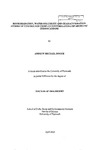Biodegradation, water solubility and characterisation studies of unresolved complex mixtures (UCMs) of aromatic hydrocarbons
| dc.contributor.author | Booth, Andrew Michael | |
| dc.contributor.other | Faculty of Science and Engineering | en_US |
| dc.date.accessioned | 2011-05-13T11:23:24Z | |
| dc.date.available | 2011-05-13T11:23:24Z | |
| dc.date.issued | 2004 | |
| dc.identifier | Not available | en_US |
| dc.identifier.uri | http://hdl.handle.net/10026.1/463 | |
| dc.description.abstract |
Following release to the environment, crude oil becomes subject to weathering processes which remove the simple, volatile hydrocarbons leaving an unresolved complex mixture (UCM) comprising the more environmentally persistent components. Aromatic UCMs have been reported in a wide variety of environmental matrices. Recent studies indicate such material, particularly monoaromatic hydrocarbons, is sufficiently bioavailable to marine organisms (e. g. mussels) to elicit toxicological responses. However, little else is known about the environmental fate and composition of petroleum-derived aromatic UCMs. The overall aim of this work was to investigate aromatic UCMs with particular emphasis on their biodegradability, water solubility and composition. To assess persistence in the environment, an 'aromatic' UCM was isolated from Tia Juana Pesado crude oil (Venezuela) and this UCM exposed to the hydrocarbon degrading bacterium Pseudomonas fluorescens (Texaco). Five synthesised alkylcyclohexyltetralins and an alkylcyclohexylnaphthalene, proposed previously as 'average' structures for some aromatic UCM components, were also exposed under the same conditions. After 50 days, biodegradation of the compounds had not exceeded 20%, the most resistant (-2% biodegradation) being those with C3-C5 alkyl chains. These latter results were comparable to those observed for the 'aromatic' UCM (-2%). Using North Sea oil or n-hexadecane as co-substrates, the synthetic compounds were also exposed to a natural consortium of bacteria to provide more environmentally realistic conditions. After 119 days the branched chain C5 homologue (-60%) and the naphthalene (-12%) still remained, yet under these severe conditions the components of the North Sea crude oil co-substrate were extensively degraded with even the highly bioresistant pentacyclic hopanes exhibiting biodegradation. Aqueous solutions of an 'aromatic' and 'monoaromatic' UCM were produced (at 25 'C) using a generator column technique. These 'solubilised' UCM fractions may represent UCM hydrocarbons which are bioavailable, and which are most toxic to aquatic organisms. An altered UCM was clearly evident in the aqueous phase extracts, suggesting that many of the compounds in the original aromatic and monoaromatic UCMs exhibited similar physicochemical properties and mole fractions. However, higher molecular weight hydrocarbons were absent from the generated 'solutions', indicating a solubility cut-off point based predominantly on molecular weight. The molecular weight distribution differed significantly for the 'solubilised' aromatic and monoaromatic UCMs, indicating that Raoult's Law may describe a critical control in the dissolution of complex mixtures. Comprehensive two-dimensional gas chromatography-time of flight-mass spectrometry (GCxGC-ToF-MS) analysis was used to provide vastly increased separation power and characterisation of a water 'soluble' monoaromatic UCM. Over 1200 compounds were separated by the chromatography, of which about 500 had distinct mass spectra from the ToF-MS analysis. A detailed characterisation of some of these monoaromatic UCM hydrocarbons via comparison to mass spectra registered in the NIST library permitted the identities of over 100 monoaromatic UCM components to be inferred. Compounds identified include novel alkylated homologues of benzene, indene, indan, tetralin, biphenyl, diphenylmethane and tetrahydrophenanthrene. This study has shown that a UCM appeared to be comprised of the geochernically minor isomers and analogues of known major crude oil constituents. This finding is extremely important given that the narcotic toxicity of petroleum hydrocarbons is additive. As UCMs often account for a large proportion of crude oil mass, these persistent residues may also contribute significantly to the observed narcotic toxicity of crude oil. | en_US |
| dc.description.sponsorship | the Natural Environment Research Council (NERC) | en_US |
| dc.language.iso | en | en_US |
| dc.publisher | University of Plymouth | en_US |
| dc.title | Biodegradation, water solubility and characterisation studies of unresolved complex mixtures (UCMs) of aromatic hydrocarbons | en_US |
| dc.type | Thesis | |
| dc.identifier.doi | http://dx.doi.org/10.24382/4803 |
Files in this item
This item appears in the following Collection(s)
-
01 Research Theses Main Collection
Research Theses Main


